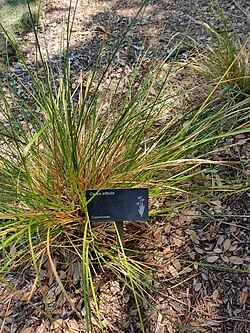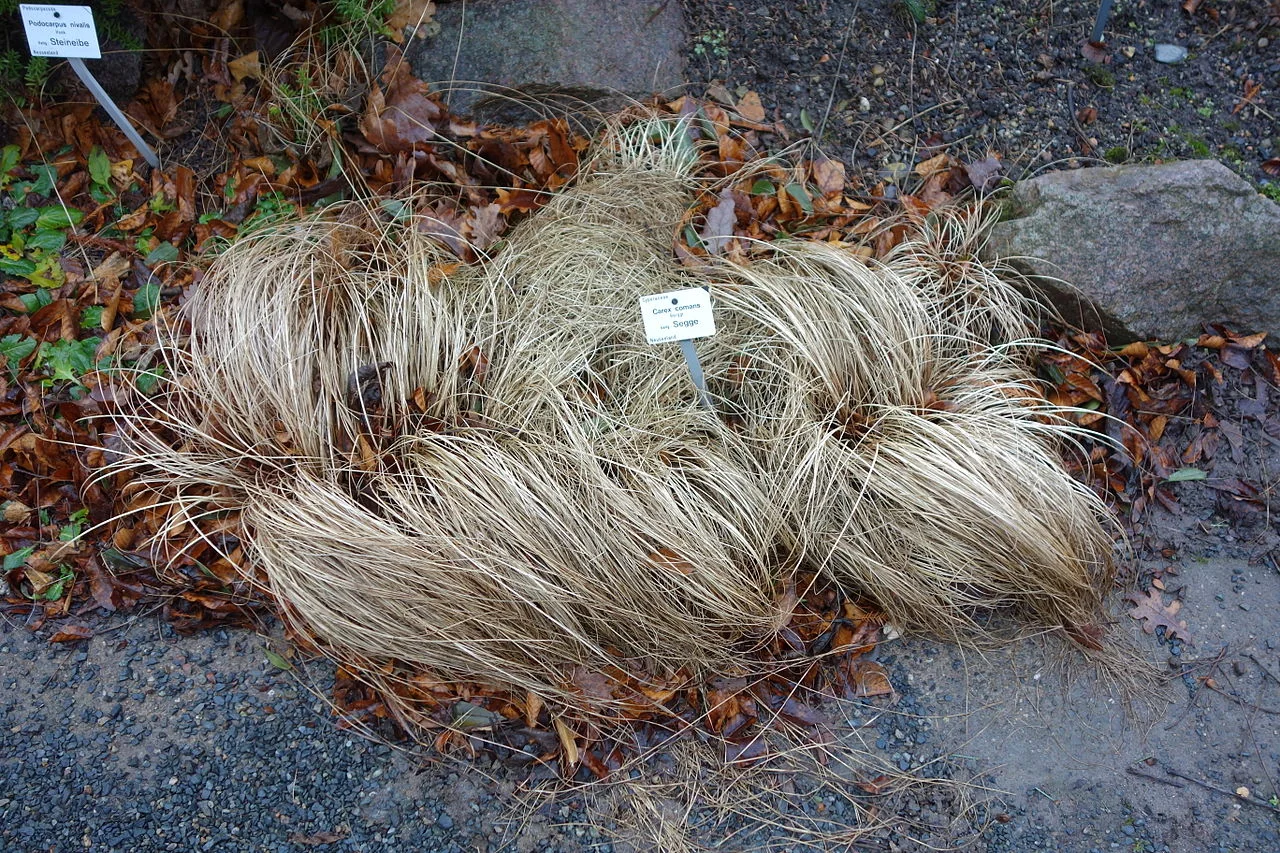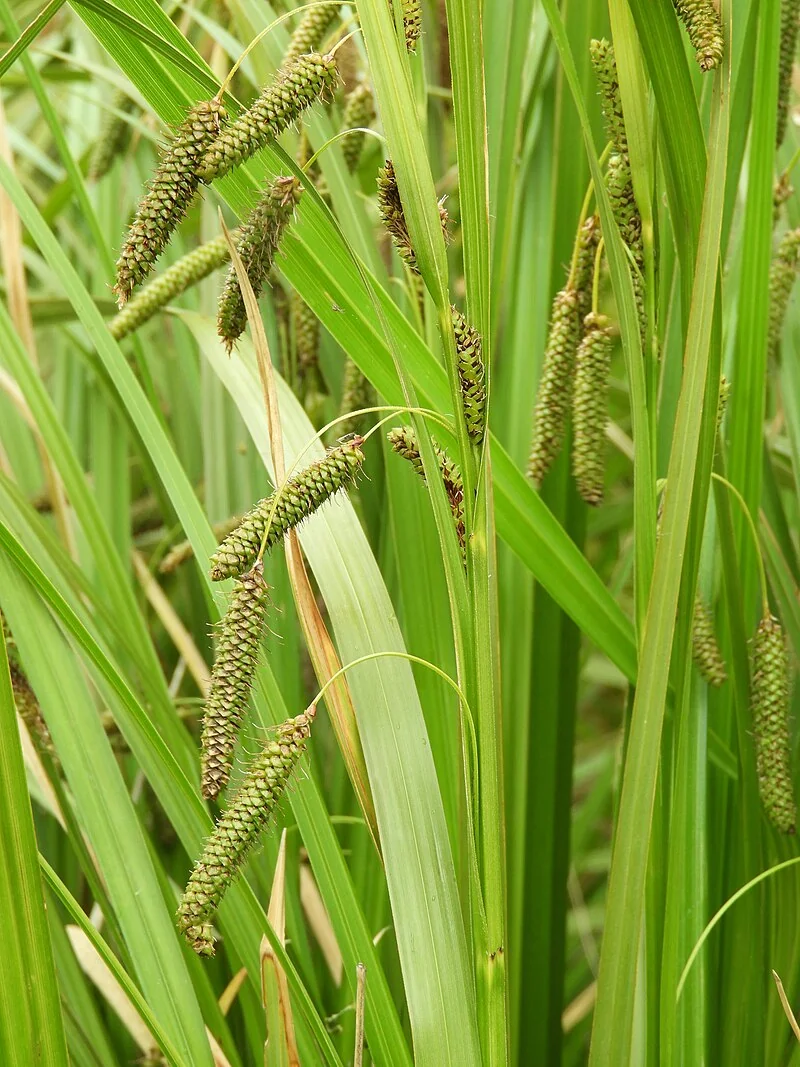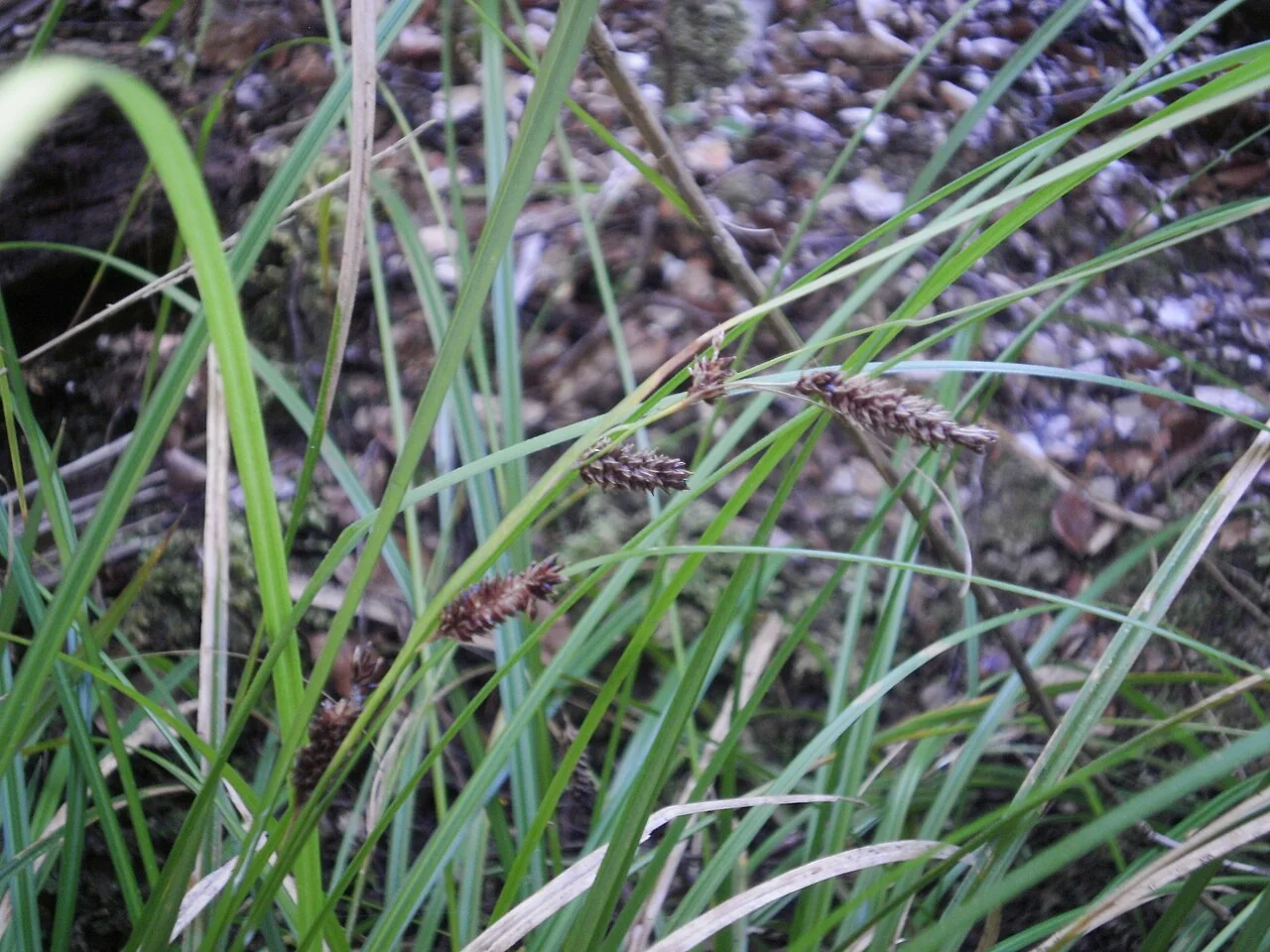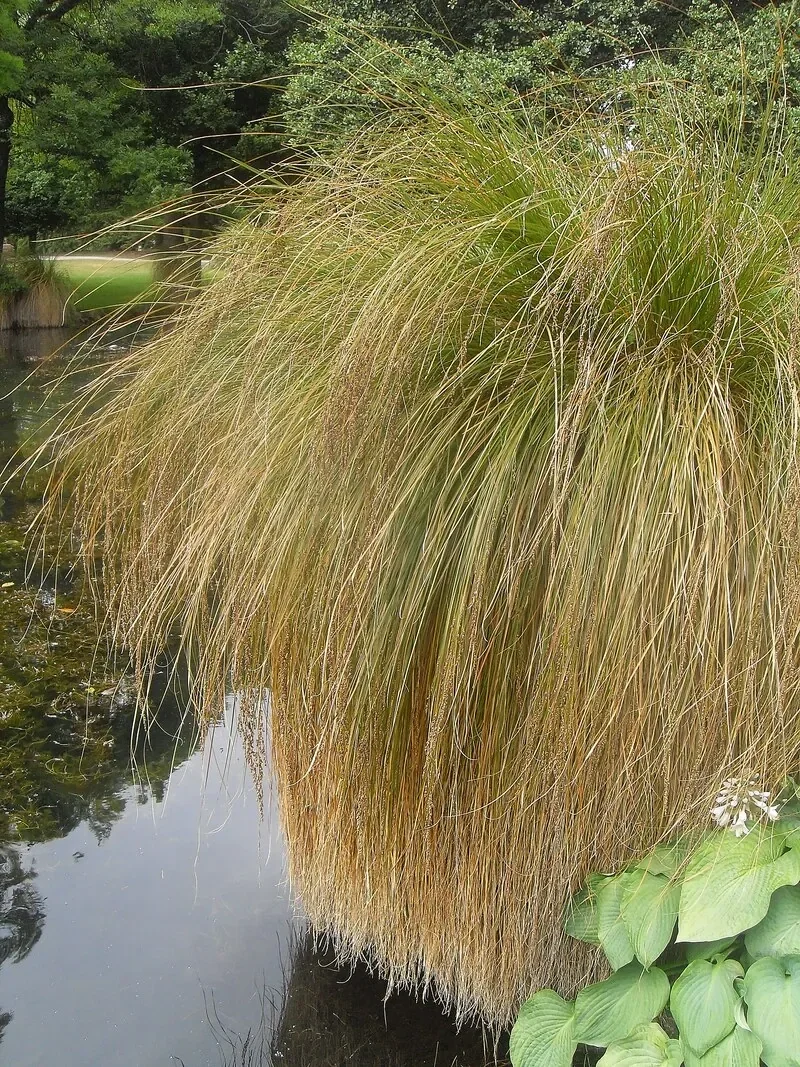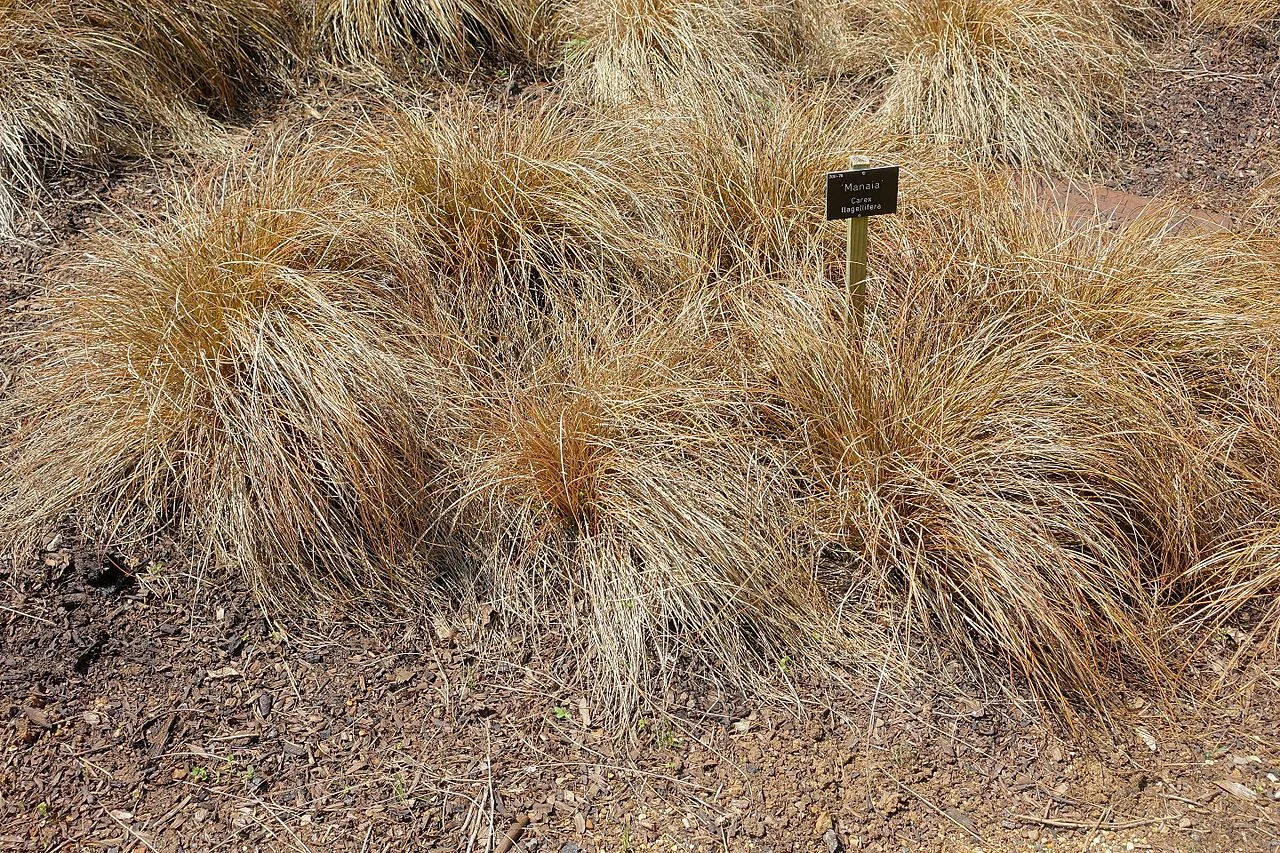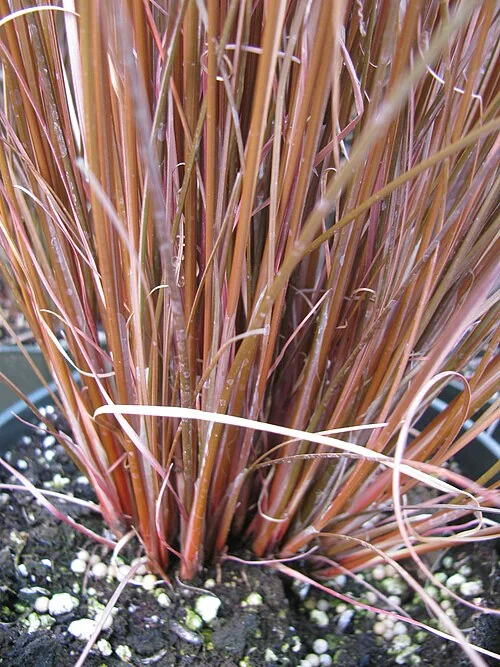
Buchanan's Sedge
Carex buchananii
Explore more NZ native plant guides in our index .
Introduction
About Leatherleaf Sedge
Carex buchananii , commonly known as Buchanan's Sedge or Leatherleaf Sedge, is a distinctive and increasingly threatened native sedge endemic to New Zealand, named in honour of John Buchanan (1819-1898), a renowned Scottish-born New Zealand botanist, scientific artist, and Fellow of the Linnean Society. This remarkable species forms dense, wiry clumps reaching 70-90cm tall with characteristically curled, coppery-bronze to reddish-brown foliage that creates striking architectural displays, particularly when grown in full sun where the metallic coloration intensifies. Currently classified as "At Risk - Declining" due to wetland habitat modification and weed competition, this culturally and ecologically significant sedge represents one of New Zealand's most ornamentally valued native grasses, thriving in diverse habitats from coastal margins to montane areas up to 1000 m elevation.

Plant Description
Carex buchananii , commonly known as Buchanan's Sedge or Leatherleaf Sedge, is a distinctive perennial sedge endemic to New Zealand. It forms dense, wiry clumps of narrow, upright, grass-like leaves that are characterized by their unique coppery-bronze to reddish-brown coloration, especially when grown in full sun. The leaves typically grow 70-90cm tall and arch gracefully at the tips, creating a striking architectural display. While its flowers are inconspicuous, the plant's distinctive foliage provides year-round interest. This sedge is valued for its ornamental qualities and its ability to thrive in diverse habitats, from coastal margins to montane areas.
Quick Facts
Sedge Summary
| Scientific Name | Carex Buchananii |
|---|---|
| Height | 30-70 cm |
| Spread | 30-50 cm |
| Water Needs | Moderate; prefers consistently moist soil |
| Light | Full sun to partial shade |
| Frost Tolerance | High |
| Salt Tolerance | Moderate |
| Growth Rate | Moderate |
| Lifespan | Perennial |
Climate Best Suited to
Carex buchananii demonstrates remarkable adaptability across New Zealand's diverse landscapes, naturally occurring from sea level coastal beaches and lagoon margins to montane areas reaching 1000 m elevation. This hardy endemic species inhabits lake and stream margins, damp ground within open forests, and short tussock grasslands, showing particular resilience in sites with fluctuating moisture levels. While more widespread on the South Island where it can be locally common, it has become increasingly uncommon on the North Island south of the Manawatu, reflecting ongoing habitat pressures that have contributed to its current "At Risk - Declining" conservation status.
Regional Suitability
| Whangārei | Ideal |
| Auckland | Ideal |
| Hamilton | Suitable |
| Rotorua | Suitable |
| Tauranga | Ideal |
| Gisborne | Ideal |
| New Plymouth | Ideal |
| Whanganui | Ideal |
| Palmerston North | Suitable |
| Napier | Ideal |
| Wellington | Ideal |
| Nelson | Ideal |
| Christchurch | Suitable |
| Dunedin | Suitable |
| Invercargill | Suitable |
| City | Climate Suitability |
|---|
Habitat
Natural Distribution
Carex buchananii , commonly known as Buchanan's Sedge or Leatherleaf Sedge, is a distinctive native sedge indigenous to New Zealand, found on both the North and South Islands. Its natural habitat spans a wide range, from coastal areas to montane regions, reaching altitudes of up to 1000 meters above sea level.
This sedge typically grows in damp environments such as beaches, and along the margins of lagoons, lakes, and streams. It can also be found in moist ground within open forests or short tussock grasslands. While it prefers full sun and consistently damp, organically rich, and well-draining soils, it can tolerate partial shade. However, it does not thrive in excessively wet soils, particularly during winter, which can lead to root rot. Its adaptability to diverse habitats, from coastal margins to montane areas, highlights its resilience, though its presence has become increasingly uncommon on the North Island south of the Manawatu due to ongoing habitat pressures.
Plant Conservation
Carex buchananii has experienced a concerning decline in conservation status, shifting from "Not Threatened" in 2013 to "At Risk - Declining" in 2017 under the New Zealand Threat Classification System. This change reflects growing concerns about population trends and habitat pressures affecting this endemic New Zealand sedge.
The species faces significant conservation challenges, particularly from drainage and modification of wetland habitats and competition from invasive weeds, especially in lowland sites. While more widespread and locally common on the South Island, it has become increasingly uncommon on the North Island, being found only at scattered sites south of the Manawatu region.
Primary threats include habitat loss through wetland drainage, modification of natural waterway margins, and invasion by exotic plant species that outcompete the native sedge. The species' preference for damp environments along beaches, lagoons, lakes, and streams makes it particularly vulnerable to coastal development and hydrological changes.
Conservation efforts focus on habitat protection, regular population monitoring, and raising awareness among landowners about potential habitats and species identification. The species' popularity in horticulture provides opportunities for ex-situ conservation and helps maintain genetic diversity while reducing collection pressure on wild populations. Ongoing survey work aims to locate new populations and monitor existing sites annually.
Growing Requirements
Soil Requirements
White maire (Nestegis lanceolata) is remarkably adaptable to different soil conditions, thriving in well-drained environments. It can tolerate a variety of soil types, from sandy to loamy, and prefers a neutral to slightly acidic pH. Good drainage is crucial to prevent root rot, ensuring healthy growth and development.
- Tolerates a wide range of soil types from clay to sandy
- Prefers well-draining soils but can handle occasional waterlogging
- Thrives in moderately fertile soils but will grow in poor soils too
- Can tolerate slightly acidic to slightly alkaline pH
- Handles coastal conditions including salt spray
Light Requirements
White maire (Nestegis lanceolata) thrives in a variety of light conditions, from full sun to partial shade. Optimal growth and flowering are typically achieved in locations receiving ample sunlight throughout the day. However, it can also tolerate some shade, especially in hotter climates, where it benefits from protection during the most intense afternoon sun.
- Full sun for optimal growth and form
- Can tolerate partial shade but may develop a leggier form
- At least 6 hours of direct sunlight daily is ideal
- Northern or eastern exposures work well in garden settings
Water Requirements
Once established, White maire (Nestegis lanceolata) is remarkably drought-tolerant, requiring minimal supplemental watering. During its establishment phase, consistent moisture is crucial to encourage strong root development. Mature plants can withstand dry periods, but regular watering during prolonged droughts will promote healthier growth and more abundant flowering.
- Moderate watering during establishment (first 1-2 years)
- Drought-tolerant once established
- Can handle periods of soil saturation
- Reduce watering in winter when growth slows
- Signs of overwatering include yellowing leaves and crown rot
Planting Guide
-
When to Plant
Plant in autumn or spring.
-
Site Preparation
Choose a sunny or partially shaded site with moist, well-drained soil.
-
Planting and Aftercare
Dig a hole twice the width of the pot. Place the plant in the hole and backfill with soil. Water well and apply a layer of mulch.
Ecological Significance
Carex buchananii , commonly known as Buchanan's Sedge or Leatherleaf Sedge, is a New Zealand native plant with several important ecological roles within its diverse habitats.
- Habitat and Shelter: It offers shelter for insects and small creatures, and its leaves can be used by birds for nesting material, contributing to local biodiversity.
- Soil Health and Erosion Control: Like other Carex species, Carex buchananii contributes significantly to soil stabilization, nutrient cycling, and water filtration. Its dense, fibrous root systems are highly effective in preventing erosion, particularly along the margins of lagoons, lakes, and streams. As its roots break down, they release nutrients and organic matter into the soil, supporting microbial communities.
- Food Source: It provides a food source for various wildlife, playing a role in the local food web.
- Water Management: Its ability to absorb excess water makes it valuable in stormwater management, and it can be utilized in rain gardens and bioswales, helping to manage water flow and prevent runoff.
- Indicator Species: Many Carex species, including Carex buchananii , serve as important indicators of wetland health, reflecting the ecological condition of these sensitive environments.
- Seed Dispersal: The nuts of Carex buchananii are dispersed through granivory (seed consumption by animals) and wind, facilitating its spread and regeneration in suitable habitats.
While generally beneficial, under ideal conditions, Carex buchananii can naturalize and potentially become invasive, particularly when cultivated outside its native range. Its conservation status in New Zealand was assessed as "At Risk - Declining" in 2017, highlighting the need for ongoing monitoring and protection of its natural populations.
Uses and Significance
Garden Uses
- Specimen tree for visual impact
- Suitable for native gardens and restoration projects
- Enhances native garden aesthetics and biodiversity
- Provides architectural accent with its unique structure
- Effective for erosion control on slopes and banks
Ecological Value
Ecologically, White maire (Nestegis lanceolata) plays a crucial role in supporting native ecosystems. Its fruits are a food source for birds, especially the kererū, contributing to the local biodiversity and food web.
- Provides a vital food source for native birds, especially the kererū
- Offers habitat and nesting sites for various fauna
- Contributes to soil stabilization and nutrient cycling
- Forms natural shelter belts, protecting other species
Cultural Significance
Traditional Uses and Values
While not as widely documented for traditional Māori uses as some other native plants, Buchanan's Sedge ( Carex buchananii ) was part of the unique high-country landscape and would have been known to local iwi. Its distinctive appearance would have made it a recognizable feature of the dry interior regions of the South Island.
Landscaping Uses
Garden Design Applications
Carex buchananii , also known as Leatherleaf Sedge or Curly Top Sedge, is a versatile ornamental grass native to New Zealand, highly prized for its distinctive coppery-bronze, fine-textured foliage that curls at the tips. It offers excellent fall colour and winter interest, making it a valuable addition to various landscape designs.
- Accent Plant: Its unique colour and texture provide striking contrast to green-leaved plants and can create a focal point in a garden, drawing the eye with its architectural form.
- Borders and Walkways: It can be mass-planted in the front of borders or along walkways to define edges, add visual interest, and create a flowing, naturalistic feel.
- Container Plantings: Its light, hair-like texture and arching form make it particularly suitable for large containers, where it can add character and texture to plant combinations on patios, balconies, or in courtyards.
- Rock Gardens: Carex buchananii looks handsome peaking out between rocks and is a good choice for rock or alpine gardens, where its hardiness and unique appearance can be highlighted.
- Rain Gardens and Water Features: Sedges generally enjoy moist conditions, making it ideal as a water marginal plant or an accent around a water feature. It can also be used in rain gardens to help manage stormwater.
- Meadow and Prairie-style Plantings: It can be dotted in meadow plantings for a naturalistic look or incorporated into prairie-style gardens, contributing to a wilder, more informal aesthetic.
- Ground Cover: While not a rapid spreader, it can be used as a slowly spreading ground cover in suitable conditions, providing year-round interest.
- Contemporary Gardens: Its unique appearance and architectural form make it well-suited for contemporary borders and modern garden designs.
- Low-Maintenance Areas: It is a low-maintenance plant, making it a good choice for areas where minimal upkeep is desired, and it is also deer-resistant.
Seasonal Care Calendar
Spring
In spring, White maire (Nestegis lanceolata) begins its active growth phase. New foliage emerges, and it's an ideal time for planting new specimens or propagating. Ensure adequate moisture and monitor for early signs of pests.
- New growth begins with fresh foliage development
- Apply a balanced, slow-release fertilizer if desired
- Excellent time for planting new specimens or dividing offsets
- Monitor for new pest activity and address promptly
Summer
Summer is the peak growing season for White maire (Nestegis lanceolata), often accompanied by flowering. Consistent watering is important, especially for young plants, to support vigorous growth and prevent stress during dry periods.
- Flowering typically occurs in early to mid-summer (November-January)
- Water young trees regularly during extended dry periods
- Avoid heavy pruning during the active growing season
Autumn
During autumn, White maire (Nestegis lanceolata) prepares for the cooler months. Fruits or berries develop, providing food for native birds. It's also a good time for planting and general garden cleanup.
- Fruits or berries develop and ripen (December-February), attracting birds
- Natural leaf shedding occurs as part of its growth cycle
- Good time for planting new specimens to establish before winter
- Clean up fallen leaves if a tidy appearance is desired
Winter
Winter is generally a dormant period for White maire (Nestegis lanceolata). Minimal care is required, though young plants may benefit from protection in colder regions. This is an opportune time for any necessary structural pruning.
- Generally dormant with minimal growth activity
- No special winter protection needed in most mild climates
- Suitable time for structural pruning if required
- Fallen leaves can be left as mulch or removed for tidiness
When to Prune and How Much
White maire (Nestegis lanceolata) generally requires minimal pruning to maintain its natural form and health. Pruning should focus on removing dead or damaged growth and shaping the plant as needed.
- Remove dead, damaged, or diseased branches at any time of year
- Light formative pruning when young helps establish good structure
- To create a multi-trunked specimen, cut the main stem to encourage branching
- Fallen leaves can be removed for a tidier appearance, or left as natural mulch
- If necessary, lower branches can be removed to create clearance underneath
- Major pruning is best done in late winter to early spring before new growth
Always use clean, sharp tools for pruning to minimize the risk of disease and ensure clean cuts. The plant often responds well to pruning with vigorous new growth, contributing to a fuller, healthier appearance.
How to Grow Buchanan's Sedge
From Division
Division represents the most reliable and efficient propagation method for Buchanan's Sedge, taking advantage of this distinctive bronze-coloured ornamental grass \'s natural clumping growth habit to create multiple plants with identical foliage characteristics. This striking sedge forms dense, fountain-like clumps through rhizomatous growth, making it exceptionally easy to divide into independent plants for landscape use or conservation purposes. The optimal timing for division is during early spring or autumn when the plant is either emerging from or entering dormancy, providing divided sections with favorable conditions for rapid root establishment. Begin by carefully lifting the entire clump using a garden fork, working gently around the perimeter to preserve the extensive fibrous root system that provides drought tolerance once established. Buchanan's Sedge develops a robust root mass that can be quite dense after several growing seasons, requiring careful handling to maintain root integrity during the separation process. Once lifted, examine the clump structure to identify natural division points where separate crowns have developed, typically visible as distinct tufts of the characteristic bronze-coloured foliage. Use clean, sharp tools to divide the clump into sections, ensuring each division includes both healthy roots and sufficient crown material to support the plant's distinctive arching habit. Divisions should be substantial enough to establish quickly, with each section including at least 3-4 healthy growing points and adequate root mass for successful transplantation. The bronze coloration that makes this species so valuable in ornamental plantings is maintained through vegetative propagation, ensuring consistent landscape impact. Replant divisions immediately at the same depth they were previously growing, spacing them 50-80cm apart to accommodate their mature size and natural spreading habit. Choose locations with full sun to partial shade and well-draining soil, as this species tolerates a wide range of conditions once established but prefers good drainage. Water thoroughly after planting to settle soil around roots, then maintain moderate moisture during the establishment period without creating waterlogged conditions. This method is particularly valuable for creating dramatic landscape effects with the species' distinctive bronze foliage and for maintaining the exact colour characteristics of superior garden forms.
From Seeds
Seed propagation provides an authentic method for growing Buchanan's Sedge that maintains genetic diversity while offering the opportunity to raise large numbers of plants for restoration or landscape projects. This prolific seeder produces abundant viable seeds that can be collected and grown successfully with attention to timing and proper growing conditions. Seeds develop during the November to June fruiting period when the distinctive silvery seed spikes mature and contain fully developed nuts within their characteristic inflated utricles. Collect fresh seeds when the utricles have turned from green to silvery-brown, indicating peak maturity and maximum viability for successful germination. Timing is important as fresh seed consistently shows much higher germination rates than stored seed, making immediate collection and sowing the preferred approach. Cut entire seed heads with clean secateurs and place them in paper bags to complete drying in a well-ventilated location away from direct sunlight. Seeds can be extracted by gently crushing the dried utricles or by allowing natural release during the drying process. Sow seeds immediately in autumn using a moisture-retentive but well-draining propagation mix that provides consistent moisture without becoming waterlogged. A mixture of quality seed-raising mix with added perlite or coarse sand ensures the drainage essential for preventing seed rot while maintaining adequate moisture for germination. Sow seeds thinly on the surface of firm, moist growing medium, covering lightly with a thin layer of fine sand or vermiculite as they benefit from some light during germination. Place seed trays in a protected location with consistent cool temperatures throughout winter, as natural stratification is essential for breaking dormancy in this temperate species. Maintain consistent moisture without waterlogging throughout the stratification period, with germination typically occurring in spring as temperatures begin to warm. Young seedlings develop slowly initially while establishing the extensive root systems that provide excellent drought tolerance in mature plants. Note that seed-grown plants may show some variation in foliage colour intensity, with the characteristic bronze coloration developing fully as plants mature over their first growing season.
From Transplanting
Transplanting established Buchanan's Sedge offers an effective method for relocating mature specimens or establishing plants in new garden areas, particularly valuable when working with proven plants that have demonstrated good performance in local growing conditions. This hardy ornamental grass transplants readily when proper techniques are followed, making it possible to move substantial clumps to create immediate landscape impact in new locations. The optimal timing for transplanting is during autumn or early spring when the plant is either entering or emerging from dormancy, reducing transplant shock and allowing time for root establishment before periods of active growth or environmental stress. Begin preparation several days before transplanting by thoroughly watering the plant to ensure tissues are fully hydrated and less susceptible to transplant stress. Carefully excavate around the entire root zone using a sharp spade, working in a circle approximately 30cm beyond the visible clump boundary to capture the extensive fibrous root system. Dig deeply enough to preserve the majority of roots, typically 25-30cm for established plants, as Buchanan's Sedge develops substantial root mass that extends well beyond the visible foliage. Lift the entire root ball carefully, supporting the weight to prevent root breakage and maintaining as much soil around the roots as possible during the transfer process. Prepare the new planting site by improving soil drainage if necessary, as this species performs best in well-draining conditions even though it tolerates a range of soil types. Dig the new planting hole slightly wider than the root ball but no deeper, ensuring the plant will be positioned at the same depth it was previously growing. Position the plant in the new location and backfill carefully with native soil or improved garden soil, firming gently to eliminate air pockets while avoiding excessive compaction. Water thoroughly after transplanting to settle soil around roots and provide adequate moisture for initial establishment, then maintain consistent but not excessive moisture during the recovery period. Apply organic mulch around the transplanted clump to conserve moisture and suppress weed competition while the plant establishes in its new location. This method is particularly effective for mature specimens that have developed the full bronze coloration and architectural form that makes this species so valuable in ornamental plantings.
Pests and Diseases
Tough and Resilient
Generally pest and disease free.
Watch for scale and fungal leaf spots; improve airflow and avoid over-watering to limit disease pressure.
Bonus Tip
Expert Growing Advice
The unique coppery-bronze to reddish-brown coloration of Buchanan's Sedge intensifies in full sun, making it a stunning feature in gardens that receive plenty of light. For the most vibrant display, plant it in an open, sunny position.
